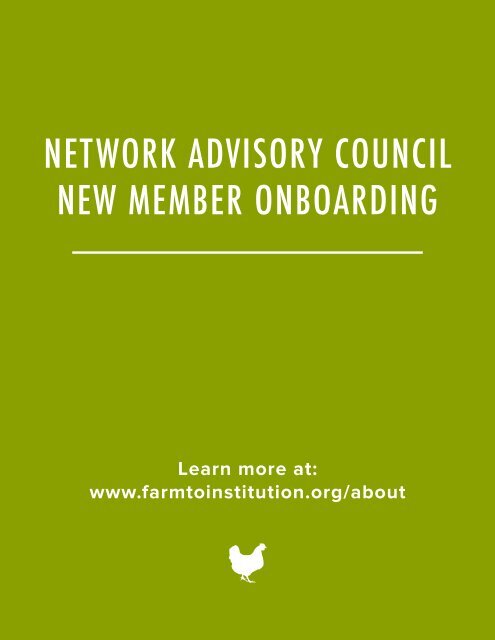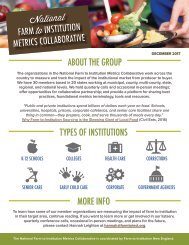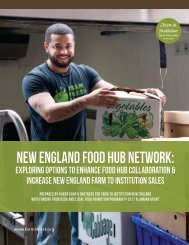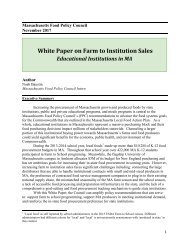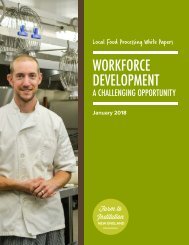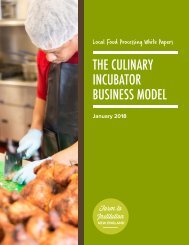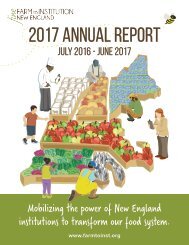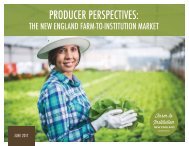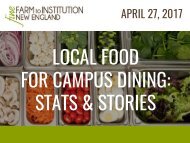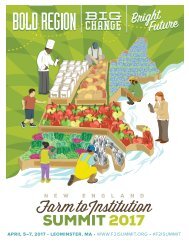FINE NAC Onboarding Packet
Create successful ePaper yourself
Turn your PDF publications into a flip-book with our unique Google optimized e-Paper software.
NETWORK ADVISORY COUNCIL<br />
NEW MEMBER ONBOARDING<br />
Learn more at:<br />
www.farmtoinstitution.org/about
2017-19 STRATEGIC PLAN<br />
Published in full January 2018<br />
Table of Contents<br />
1. Guiding Ideas<br />
2. Goals, Indicators & Strategies<br />
3. Implementation
Part 1: Guiding Ideas<br />
Mission<br />
To mobilize the power of New England institutions to transform our food system.<br />
Vision<br />
Preamble: <strong>FINE</strong>’s vision is in alignment with those of many other food system entities, including<br />
the New England Food Vision created by Food Solutions New England. The vision we hold<br />
places emphasis on both the way that institutions and the farm to institution network will be<br />
operating, and the cultural conditions we see existing by 2030.<br />
By 2030, we envision New England institutions and the <strong>FINE</strong> network playing leadership roles in<br />
cultivating a region that is moving towards self-reliance. We envision an equitable and just food<br />
system that provides access to healthy and abundant food for all New Englanders, and is defined<br />
by sustainable and productive land and ocean ecosystems.<br />
Role<br />
In alignment with our values, mission, and vision, <strong>FINE</strong> works in three primary ways. We: 1) serve<br />
as the backbone for the farm to institution network in New England, 2) catalyze collaborative<br />
projects that address key barriers in the New England institutional supply chain, and 3) advance a<br />
policy and programmatic agenda.<br />
Core Values<br />
Preamble: <strong>FINE</strong>’s values have been developed to reflect our collective aspirations and guide us<br />
in carrying out our mission to transform the food system. These values reinforce each other and<br />
are not to be viewed in isolation. Together they reflect the need for whole systems thinking to<br />
understand and integrate the complex connections of the people, programs and policies related<br />
to the food system. They aim to create a high level of accountability, trust, and identity, both<br />
internally within the network and externally to our stakeholders and the broader public. Our<br />
values guide our behavior and articulate what we think is important. We commit to being<br />
intentional and aware about how our work reflects these values.<br />
We value:<br />
Collaboration: Networks of diverse actors working together with a spirit of trust and generosity<br />
toward shared goals.<br />
Community & Place: Place-based multi-state approaches that build on the unique geographic<br />
identity and history of our New England communities and region to promote relationships and<br />
foster productive change.<br />
Diversity: All dimensions of diversity, which include (but are not limited to) age, sexual<br />
orientation, ethnicity, ancestry, gender identity, race, physical abilities, marital status, military
experience, religious beliefs, economic class, geography, education, parental status and/or work<br />
experience. These inform a wide range of opinions, traditions, approaches, backgrounds,<br />
communities, and ways of knowing.<br />
Equity: Fair and just access to resources and opportunities for all within the food system and<br />
beyond, regardless of any dimension of diversity.<br />
Healthy Ecosystems: The integrity and biodiversity of natural systems. From recycling nutrients<br />
to promoting healthy fish stocks, crop diversity, soil and water quality, energy conservation, and<br />
resilience in the face of changing climates, we recognize that the wellbeing of people and planet<br />
are inextricably linked.<br />
Strategic Disruption: Actions that directly challenge elements of the food system that run<br />
counter to our values.<br />
The Right to Food: The belief that everyone deserves access to nutritious, affordable,<br />
sustainably produced, culturally appropriate food.<br />
Thriving Local Economies: Economies that cultivate socially equitable, financially viable, and<br />
environmentally healthy food systems and ensure that economic power resides locally to the<br />
greatest extent possible. This includes ensuring decent and dignified livelihoods for farmers,<br />
community-based fishermen and all supply chain workers.<br />
Transparency: Open access to information that has the potential to create positive change in the<br />
food system, and a commitment to honesty regarding goals and purpose when working in<br />
collaboration.
Part 2: Goals, Indicators & Strategies<br />
Following are the <strong>FINE</strong> goals for our work, indicators of success and strategies that we will follow<br />
over the next three years (fiscal years 2018-2020). They are built on the foundation of our<br />
enduring values, vision, mission, and role.<br />
Definitions of key terms for this document<br />
Farm to Institution: The infrastructure, processes, supply chain relationships, and policies that<br />
enable food to travel from producers to institutional consumers within the region.<br />
Stakeholder: A person with some relationship to the institutional food system, including<br />
institutions, distributors, food service operators, food system organizations, and producers,<br />
including all members of the <strong>FINE</strong> network.<br />
<strong>FINE</strong> Network: People who are connected to <strong>FINE</strong> via projects, events, committees, or<br />
communication platforms.<br />
Institution: Any organized entity that creates a demand for food and serves food to a defined<br />
population. <strong>FINE</strong>’s programs target K-12 schools, colleges, and hospitals.<br />
Local: At this time, <strong>FINE</strong> does not have a single definition of “local food.” <strong>FINE</strong> recognizes that<br />
many of the New England states and partner organizations have their own definitions of “local<br />
food,” as does the USDA.<br />
Sustainable: A means of production that promotes the long-term viability of natural or social<br />
systems and is reflective of <strong>FINE</strong>’s values.<br />
Food: Any item that is a form of sustenance. <strong>FINE</strong>’s priority is to increase the proportion of foods<br />
consumed that meet healthy diet standards and are culturally appropriate.<br />
Community of Practice: A temporary cohort of practitioners and partners with expertise in a given<br />
topic who gather to share information related to that topic. In some cases, these COPs generate<br />
cooperative solutions to common challenges.<br />
Region: <strong>FINE</strong>’s region is New England. We recognize that for states that border states or<br />
provinces outside New England, their definition of region may include those border states or<br />
regions.<br />
Summary<br />
Goal 1: More local food served at institutions<br />
Goal 2: A more developed and diverse regional network of individuals and entities across all<br />
parts of the food system that are mobilizing the power of institutions to transform the food system<br />
Goal 3: Broader stakeholder understanding of the role of farm to institution<br />
Goal 4: Stronger state and federal policies in support of farm to institution<br />
Goal 5: A stronger organizational foundation to support <strong>FINE</strong>’s mission-driven work
Goal 1: More local food served at institutions<br />
Indicators of Success<br />
●<br />
●<br />
●<br />
●<br />
More local food purchasing expenditures:<br />
○ 5% average increase in local food purchases across surveyed schools, campuses,<br />
and health care facilities between 2015 and 2020 (as measured by <strong>FINE</strong>’s metrics<br />
initiative)<br />
More purchasing goals:<br />
○ Baseline measurement of the number of institutions that have stated goals around<br />
local food purchasing in their food service contracts or other documentation<br />
More tracking:<br />
○ Percentage of colleges and universities that track local food purchases with a<br />
specified tool increases from 68% to 80% from 2015 to 2018 (as measured by<br />
<strong>FINE</strong>’s metrics initiative)<br />
More viable farm and fishing businesses in New England:<br />
○ Increase in the overall number of producers<br />
○ Reduction in off-farm employment among farm owners<br />
○ Increase in the number of producers selling to intermediaries<br />
○ Increase in the volume of direct-to-institutions sales<br />
Core Strategies<br />
A. Events: Convene institutional stakeholders to share local procurement best practices.<br />
B. Research & Tools: Conduct original research to capture institutional local procurement<br />
strategies and create tools, resources, and trainings based on results.<br />
C. Technical Assistance: Develop and implement programs that focus on specific<br />
institutions and producers to demonstrate strategies in action and move the sector<br />
forward.<br />
D. Measurement: Continue to hone metrics to measure progress through collaboration with<br />
leaders in the region and around the country.<br />
E. Outreach: Conduct outreach and public relations that will increase demand for local food<br />
by stakeholders at institutions.<br />
Goal 2: A more developed and diverse regional network<br />
of individuals and entities across all parts of the food<br />
system that are mobilizing the power of institutions to<br />
transform the food system<br />
Indicators of Success<br />
●<br />
Deeper participation in the <strong>FINE</strong> network:
●<br />
●<br />
●<br />
○ 15% increase in the number of individuals and/or organizations in total and from<br />
each state who consider themselves “somewhat” or “very” active members of the<br />
<strong>FINE</strong> network, according to responses to <strong>FINE</strong>’s stakeholder survey<br />
○ Each state has a group of farm to institution stakeholders and decision makers<br />
who meet and collaborate at least two times per year<br />
Broader advisory representation across <strong>FINE</strong>:<br />
○ <strong>FINE</strong> advisory bodies (e.g., <strong>NAC</strong> and committees, program/project advisory<br />
groups) have representatives from government, business, nonprofit sector, and<br />
seafood-focused entities<br />
Increased engagement with <strong>FINE</strong> network communications program:<br />
○ 25% increase in e-newsletter subscribers each year for the next three years, with a<br />
30% open rate, on average<br />
○ 10% increase in unique visitors across <strong>FINE</strong>’s websites per year, on average<br />
○ 15% increase in <strong>FINE</strong> followers on Facebook and Twitter per year<br />
○ At least five requests, on average, per month for <strong>FINE</strong> support in communicating<br />
events, activities, research findings, and other similar services<br />
A more diverse network:<br />
○ More diversity in <strong>FINE</strong> network membership and member participation in <strong>FINE</strong><br />
programs<br />
○ Makeup of the <strong>FINE</strong> network is reflective of the diversity of the region<br />
Core Strategies<br />
A. Award Program: Start an award program to celebrate institutions that demonstrate the<br />
value of <strong>FINE</strong>’s mission to mobilize the power of institutions to transform the food system.<br />
B. Storytelling: Compile and communicate stories that demonstrate the value of <strong>FINE</strong>’s<br />
mission, vision, and priority goals each year for three years.<br />
C. Membership: Explore membership options (e.g., structures, benefits, responsibilities) and<br />
move forward with one of the options.<br />
D. Communities of Practice: Identify and convene two to three high-value communities of<br />
practice that support farm to institution work in the region.<br />
E. Partnerships: Engage a wide array of stakeholder organizations with the aim of<br />
expanding their awareness of the role of farm to institution and increasing perspectives in<br />
<strong>FINE</strong>’s program planning and implementation.<br />
F. Council: Actively utilize Network Advisory Council members and take advantage of the<br />
group’s standing and ad hoc committees in order to gain guidance on key programmatic<br />
and organizational issues.<br />
G. Outreach: Perform targeted outreach (e.g., communications, programming) to<br />
organizations representing diversity to join the <strong>FINE</strong> network and participate in <strong>FINE</strong>’s<br />
network and programs.<br />
H. Diverse Programs: Feature diverse representatives as speakers at events and in stories<br />
on our website, and integrate this content into our regular programming as opposed to<br />
reserving it for when we address equity or diversity.
Goal 3: Broader stakeholder understanding of the role of<br />
farm to institution<br />
Indicators of Success<br />
● More programming:<br />
○ 10% more workshops, discussions, and conversations about farm to institution at<br />
primary food and agriculture events in New England (e.g., NESAWG, Harvest New<br />
England) each year<br />
○ 10% more professional development opportunities for institutional food service<br />
staff to learn about local procurement, seasonal menus, and cafeteria promotion<br />
each year<br />
● More usage of farm to institution language:<br />
○ 10% increase in the use of the phrase “farm to institution” as a term that refers to<br />
regional supply chains serving a variety of institutions (as measured by Google<br />
Alerts)<br />
● More food committees:<br />
○ 10% more institutions have active food or wellness groups (as measured by <strong>FINE</strong>’s<br />
metrics initiative), between 2015 and 2018<br />
● More diversity represented in <strong>FINE</strong>’s communications:<br />
○ 50% of newsletters and 25% of case studies represent photos or stories of diverse<br />
populations or institutions around the region<br />
● Broader stakeholder engagement in the <strong>FINE</strong> network (see goal 2)<br />
Core Strategies<br />
A. Key Messages: Craft strong messages and compelling stories about the value of farm to<br />
institution.<br />
B. Communicating Importance: Communicate the importance of farm to institution to all<br />
stakeholders, including <strong>FINE</strong> network members, policy makers, institutional leaders, and<br />
supply chain operators.<br />
C. Resources: Expand the number and value of tools and resources that support farm to<br />
institution efforts.<br />
Goal 4: Stronger state and federal policies in support of<br />
farm to institution<br />
Indicators of Success<br />
●<br />
Defined role for <strong>FINE</strong> in the policy arena (6-12 months out)<br />
○ Critical partners are identified for this work and relationships with them have been<br />
established<br />
○ There are clearly articulated criteria, including criteria for equity and diversity, for<br />
when <strong>FINE</strong> signs onto a policy action, pushes a policy opportunity to its network,<br />
or takes a leadership role on policy issues
○ There is a defined role for <strong>FINE</strong> in advocacy related to federal policy issues<br />
including the Farm Bill, Fish Bill, Child Nutrition Reauthorization, and Dietary<br />
Guidelines<br />
● Clear policy platform established (12-24 months out)<br />
○ For each of the six New England states, there is a completed review of<br />
state-based policies that are relevant to farm to institution<br />
○ Types of state-based policies that are highest leverage for <strong>FINE</strong> agenda have<br />
been identified<br />
○ Explicit priorities for state-based advocacy have been identified<br />
○ Explicit priorities have been set for the next Farm Bill and Child Nutrition<br />
Reauthorization Act<br />
○ <strong>FINE</strong> has completed a written report with stated goals and priorities related to<br />
regional and national policies<br />
● Policy agenda implemented (years 2-5)<br />
○ A set of specific process and outcome goals have been articulated based on<br />
policy platform<br />
○ 75% of process-based goals established in platform<br />
Core Strategies<br />
A. State Food Plans: Deepen involvement in the community of practice for New England<br />
state food planners.<br />
B. Policymakers: Deepen communication with key state and federal food policy makers and<br />
policy advocates.<br />
C. Policy Priorities: Work with leaders in the states in order to determine appropriate<br />
national, regional, and state farm to institution-related policy priorities.<br />
D. Policy Research: Perform targeted policy research and analysis.<br />
E. Policy Platform: Produce a collaboratively-developed, regional farm to institution policy<br />
platform and infuse a leading national good food policy platform with farm to<br />
institution-focused elements.<br />
F. Advocacy: Provide state testimony and advocacy materials upon request.<br />
Goal 5: <strong>FINE</strong>’s mission-driven work is built upon a<br />
stronger organizational foundation<br />
Indicators of Success<br />
●<br />
●<br />
More and broader funding:<br />
○ <strong>FINE</strong> has an annual fund development plan<br />
○ <strong>FINE</strong> has received funding from two additional foundations or institutional donors<br />
○ 25 new individual donors give to <strong>FINE</strong> in each of the next three years<br />
Stronger governance:<br />
○ The role of the Network Advisory Council is clearly defined<br />
○ 80% or more Network Advisory Council (<strong>NAC</strong>) members attend each <strong>NAC</strong><br />
meeting, on average
●<br />
●<br />
●<br />
●<br />
○ Three or more sub-committees each meet a minimum of three times per year<br />
Strong staff team:<br />
○ All staff have professional development plans that include opportunities for<br />
personal and professional growth<br />
○ All staff are satisfied with their work<br />
○ Staff share responsibilities for leadership and/or decision making<br />
○ We have an adequate staff team to meet our goals and commitments<br />
More accountability and clearer direction:<br />
○ <strong>FINE</strong> staff with support from Network Advisory Council members use the strategic<br />
plan to track work on a quarterly basis and adjust indicators and work plans<br />
○ Staff use strategy filter to make decision on new opportunities<br />
Stronger evaluation:<br />
○ <strong>FINE</strong> has a program of evaluation that measures the impact of our core programs<br />
A more diverse team:<br />
○ <strong>FINE</strong>’s Network Advisory Council, staff, consultants, and interns reflect the<br />
demographics of New England in terms of race, class, age, gender identity, sexual<br />
orientation, and other identifiers<br />
Core Strategies<br />
A. Development Plan: Create a development plan for each fiscal year.<br />
B. Advisor Engagement: Engage <strong>FINE</strong>’s Network Advisory Council as a whole and as<br />
individual council members on a regular basis in a systematic way.<br />
C. Staff Development: Perform regular staff development and team-building activities.<br />
D. Strategy: Use strategic plan as a “living document.”<br />
E. Evaluation: Develop and implement a program of evaluation.<br />
F. Professional Development: Invest in professional development opportunities on diversity<br />
and racial equity for <strong>FINE</strong>’s Network Advisory Council members and staff.<br />
G. Internal Policy: Develop an internal policy to ensure that issues of diversity, inclusion, and<br />
equity are represented in decision-making by staff and advisors.<br />
H. Diverse Team: Ensure that all new <strong>FINE</strong> advisory teams and core groups are diverse in<br />
their initial composition and in recruitment of new members.<br />
I. Evolution: Make specific, positive changes as a result of critical feedback related to<br />
diversity on evaluations and assessments, both formal and informal.
Part 3: Implementation<br />
Strategy Filter<br />
This filter is used to assess opportunities (or threats) that arise and to help us determine whether and how to<br />
adjust our current work plan. Opportunities may include a new project, partnership, involvement in a meeting<br />
or conference, or other effort that will require a commitment of our energy, resources, thinking, and brand.<br />
The filter helps us remain nimble and responsive to new opportunities and yet be accountable to existing<br />
commitments and plans.<br />
The filter is divided into two sections. The first seven categories correlate to <strong>FINE</strong>’s strategic plan and<br />
organizational mission. The last two categories relate to staff and budget capacity. When an opportunity<br />
receives between 14 and 21 points in the first part of the filter, it will progress to the second section. If it<br />
scores below 14 points or receives any zeros, it will be revisited and modified before moving ahead to the<br />
second section. Note that “New England” is abbreviated to “NE.”<br />
0 POINTS [RED FLAG] 1 POINT 2 POINTS 3 POINTS<br />
Values &<br />
Mission &<br />
Vision<br />
Conflicts with one or<br />
more key values<br />
Involves food system or<br />
institutions<br />
NE institutions and NE<br />
food system<br />
NE institutions and NE<br />
food system and other<br />
values<br />
Geography No NE connection Nationwide with a<br />
moderate impact on NE<br />
1 to 5 NE states, may<br />
inform regional strategy<br />
or benefit other NE<br />
states<br />
All six NE states and<br />
may include nationwide<br />
impacts<br />
Sectors<br />
Does not relate to<br />
institutions<br />
Serves only one of our<br />
core sectors<br />
Serves two or three of<br />
our core sectors<br />
Serves all of the core<br />
sectors<br />
Local Food<br />
Served at<br />
Institutions<br />
Does not directly<br />
increase local food at<br />
institutions<br />
Indirectly supports local<br />
food at institutions<br />
(education)<br />
Very supportive of<br />
activities that increase<br />
local food at institutions<br />
Creates measurable<br />
increase in local food at<br />
institutions<br />
Network<br />
Duplicates, confuses or<br />
conflicts with work of<br />
other partners<br />
Unclear demand from or<br />
conflicts with partners<br />
High demand for work,<br />
some overlap with other<br />
partners<br />
No other partner does<br />
the work; all partners<br />
want the work done<br />
Stakeholder<br />
Awareness<br />
Will not increase<br />
stakeholder awareness<br />
Low visibility and<br />
unclear impact of story<br />
or data<br />
High visibility OR<br />
compelling story or data<br />
High visibility and<br />
compelling story or data<br />
Food System<br />
Impact Through<br />
our Key Values<br />
No impact on regional<br />
food systems<br />
development or<br />
institutional markets<br />
Impact on regional food<br />
systems, but not<br />
institutional markets -<br />
national or state level<br />
Small impact on both<br />
regional food systems<br />
and institutional markets<br />
- national or state level<br />
Large impact on both<br />
regional food systems<br />
and institutional markets<br />
- national or state level<br />
Staff Capacity<br />
No new funds or good<br />
fit for current staff<br />
capacity<br />
Hire new staff with<br />
project funds<br />
Have staff skills but<br />
need to shift workload<br />
Will put existing staff<br />
skills and capacity to<br />
work<br />
Budget/<br />
Funding<br />
Prevents us from doing<br />
other core work<br />
Pays for project costs<br />
Covers project costs<br />
and some general<br />
operating<br />
Generates<br />
unrestricted revenue
NETWORK ADVISORY COUNCIL<br />
MEMBER ORIENTATION<br />
THE <strong>FINE</strong> BASICS<br />
A PRIMER TO FARM TO INSTITUTION NEW ENGLAND
OVERVIEW
OUR MISSION<br />
To mobilize the power of<br />
institutions to transform<br />
our food system
OUR HISTORY<br />
Founded in 2011<br />
as a partnership among regional<br />
farm to school leaders and the six<br />
New England agricultural<br />
commissioners<br />
Photo: Hampshire College
WHY INSTITUTIONS?<br />
Diversified and stable market<br />
Serve 3.8 million people per day<br />
Buy 17% local food, on average<br />
Want to buy more local food<br />
Major employers
WHY REGIONAL?<br />
More producers up north and<br />
more consumers down south<br />
Distributors and FSMCs operate<br />
across state lines<br />
Shared history + culture ➡ collaboration
WIDE-REACHING IMPACT<br />
4,628<br />
Schools<br />
210<br />
Colleges<br />
256<br />
Hospitals<br />
And 34,877 farms in New England
CORE VALUES<br />
Collaboration<br />
Diversity<br />
Equity<br />
Transparency<br />
Community & Place<br />
Healthy<br />
Ecosystems<br />
Strategic<br />
Disruption<br />
The Right to Food<br />
Thriving Local<br />
Economies
OUR GOALS<br />
Goal 1: More local food purchased by regional institutions<br />
Goal 2: A more developed and diverse regional network of individuals and<br />
entities across all parts of the food system that are mobilizing the power of<br />
institutions to transform the food system<br />
Goal 3: Broader stakeholder understanding of the role of farm to institution<br />
Goal 4: Stronger state and federal policies in support of farm to institution<br />
Goal 5: A stronger organizational foundation to support <strong>FINE</strong>’s<br />
mission-driven work
WHAT <strong>FINE</strong> OFFERS<br />
NETWORK SERVICES<br />
EVENTS & TRAININGS<br />
COMMUNICATIONS<br />
RESEARCH & METRICS<br />
PROGRAMS<br />
FARM TO CAMPUS<br />
CAMPUS FOODSHIFT<br />
FOOD SERVICE<br />
PUBLIC POLICY<br />
COMMUNITIES OF<br />
PRACTICE<br />
PROCESSORS<br />
FOOD HUBS<br />
METRICS ENTHUSIASTS<br />
DINING OPERATORS
OUR TEAM<br />
The <strong>FINE</strong> team has many players,<br />
including staff, interns, fellow(s),<br />
the Network Advisory Council (18<br />
members), campus working groups,<br />
and various project advisory boards.
NETWORK SERVICES
EVENTS & TRAININGS<br />
We host the biennial Northeast<br />
Farm to Institution Summit as<br />
well as other convenings and<br />
webinars. Our staff also makes<br />
dozens of presentations at<br />
partner events each year.
COMMUNICATIONS<br />
We regularly communicate with our<br />
network of more than 2,800 partners<br />
through <strong>FINE</strong>’s website, blog,<br />
e-newsletter, social media, key<br />
stakeholder outreach and more.
RESEARCH & METRICS<br />
The information we share about the<br />
state of farm to institution through<br />
our dashboard, research reports,<br />
webinars, and other publications is<br />
built from a foundation of primary and<br />
secondary research.
PROGRAMS
FARM TO CAMPUS<br />
The New England Farm & Sea to<br />
Campus Network is a community of<br />
higher education and food systems<br />
stakeholders who connect, share, and<br />
collaborate to develop transparent<br />
regional supply chains and educate<br />
campus communities about regional<br />
food systems.
CAMPUS FOODSHIFT<br />
We’re providing technical assistance<br />
to pilot campuses, helping them to:<br />
(1) increase the amount of local food<br />
they procure, (2) build informed and<br />
active campus communities, and (3)<br />
participate in a region-wide cohort of<br />
other campuses committed to<br />
building strong local food programs.
FOOD SERVICE<br />
We offer a toolkit called “Setting the Table<br />
for Success: Increasing Local Food Purchasing<br />
by Institutions”to help food service providers<br />
at schools, colleges and hospitals navigate<br />
the process of buying local food. Plus, we’ve<br />
published guides that help demystify the<br />
world of food service management companies.<br />
<strong>FINE</strong>’s food service toolkit is available online:<br />
www.farmtoinstitution.org/food-service-toolkit
PUBLIC POLICY<br />
Our new strategic plan<br />
identifies the development of<br />
“stronger state and federal<br />
policies in support of farm to<br />
institution,” as one of five core<br />
goals. In early 2018, <strong>FINE</strong><br />
launched a policy working group<br />
to help us reach this goal.
COMMUNITIES OF<br />
PRACTICE
LOCAL FOOD PROCESSORS<br />
Photo: Vermont Food Venture Center<br />
The New England Local Food Processors<br />
Community of Practice was formed to<br />
create a culture of collaboration and<br />
teamwork among food processing facilities<br />
in New England that serve food businesses,<br />
farms, distributors, schools, colleges,<br />
hospitals, restaurants, retailers, and others.
FOOD HUB NETWORK<br />
In 2016, <strong>FINE</strong> received a USDA LFPP<br />
Planning Grant to explore opportunities<br />
for food hubs to increase their sales to<br />
regional institutions in order to increase<br />
the amount of local food flowing into<br />
institutions, and leverage institutional<br />
markets for food hub growth and long<br />
term viability.
METRICS COLLABORATIVE
DINING OPERATORS<br />
<strong>FINE</strong> coordinates a listserv for campus<br />
dining operators such as nutrition directors,<br />
chefs, and procurement specialists, with a<br />
current membership of nearly 100<br />
individuals.
KEY TOOLS
METRICS DASHBOARD<br />
NEW ENGLAND FARM TO<br />
INSTITUTION METRICS DASHBOARD<br />
Your source of cross-sector metrics<br />
measuring the breadth and impact of farm<br />
to institution in six states<br />
Explore the dashboard:<br />
dashboard.farmtoinstitution.org
RESEARCH REPORTS<br />
Download digital copies of these three research reports and watch<br />
recordings of our one-hour webinars about key findings:<br />
dashboard.farmtoinstitution.org/research-reports
STATE PROFILES<br />
Download state profiles for all six New England states:<br />
dashboard.farmtoinstitution.org/state-profiles
BLOG SERIES<br />
Read our six-part farm to institution metrics blog series:<br />
dashboard.farmtoinstitution.org/measuring-up
FOOD SERVICE TOOLKIT
CASE STUDIES<br />
Want to learn about how institutions<br />
around New England are sourcing local<br />
food, growing their own, and spreading<br />
the word? Check out our set of case<br />
studies featuring exciting farm to<br />
institution initiatives at colleges, schools<br />
and hospitals.
EVENTS
PARTNER EVENTS<br />
Our team members actively participate<br />
in the programs offered by many<br />
partners organizations by presenting at<br />
their conferences and events, and<br />
attending their meetings.
WEBINARS
MEETINGS<br />
<strong>FINE</strong> hosts a variety of<br />
project-focused and big-picture<br />
meetings throughout the year, both<br />
in-person and virtual.
SUMMIT
THANKS FOR<br />
TUNING IN!<br />
Photo: Hampshire College
2017 ANNUAL REPORT<br />
JULY 2016 - JUNE 2017<br />
Mobilizing the power of New England<br />
institutions to transform our food system.<br />
www.farmtoinst.org<br />
1
FY2017<br />
ANNUAL REPORT<br />
Director’s Letter<br />
Dear <strong>FINE</strong> Friends,<br />
The 2017 New England Farm to Institution Summit in April was a watershed<br />
moment for the farm to institution movement. Watching the nearly 500 leaders from<br />
all parts of the value chain share their experiences and make connections to source<br />
more local food, I was struck by how much has changed since 2011 when <strong>FINE</strong> was<br />
launched. It’s clear, farm to institution is not just a promising idea, but it has become<br />
an established part of our institutional food culture. We are having an impact – and<br />
yet our work is far from complete.<br />
This past year, <strong>FINE</strong>’s metrics program has deepened our collective understanding<br />
of this system we are working to change. We now have a good baseline of local food<br />
procurement percentages and practices for the three sectors we focus on, as well<br />
as institutional sales data for distributors who deliver the food and the farmers who<br />
produce it. We also better understand the motivations and barriers for all.<br />
Our New England Farm & Sea to Campus Network has emerged to serve as a<br />
valuable forum for campus food system leaders to exchange ideas and develop tools<br />
to address critical barriers in their sector. Campus FoodShift was launched to apply<br />
these tools to select institutions that are ready to step forward as the next cohort of<br />
local food system leaders.<br />
<strong>FINE</strong>’s food service program, which features a local food buying toolkit for food<br />
service professionals, continues to help partners navigate the sometimes opaque<br />
and dynamic world of food system contracts that define the opportunities and<br />
barriers of local food practices.<br />
<strong>FINE</strong>’s Network Advisory Council and staff team have also deepened our<br />
commitment to our core values and updated our mission statement, vision, and<br />
goals to align with the broader purpose of our work and to clarify our path forward.<br />
The <strong>FINE</strong> team is pleased to share the highlights of our work in fiscal year 2017.<br />
Thank you for partnering with us on this journey!<br />
Sincerely,<br />
2<br />
Peter Allison<br />
Network Director<br />
Farm to Institution New England
OUR MISSION<br />
To mobilize the power of New England<br />
institutions to transform our food system<br />
OUR VISION<br />
By 2030, we envision New England<br />
institutions and the <strong>FINE</strong> network playing<br />
leadership roles in cultivating a region that<br />
is moving towards self-reliance.<br />
We envision an equitable and just food<br />
system that provides access to healthy and<br />
abundant food for all New Englanders, and<br />
is defined by sustainable and productive<br />
land and ocean ecosystems.<br />
OUR VALUES<br />
We value collaboration, community and<br />
place, diversity, equity, healthy ecosystems,<br />
strategic disruption, the right to food,<br />
thriving local economies, and transparency.<br />
3
BY THE NUMBERS<br />
NEW ENGLAND<br />
FARM TO INSTITUTION<br />
4,628<br />
K-12 Schools<br />
210<br />
Colleges & Universities<br />
256<br />
Hospitals<br />
34,877<br />
Farms<br />
3.8 million<br />
People eat at<br />
institutions every day<br />
17% local<br />
Average percent of food<br />
budget spent on local<br />
food across institutions*<br />
*Based on surveyed populations<br />
ENGAGEMENT<br />
450<br />
Summit attendees<br />
915<br />
Webinar registrations<br />
32<br />
Advisors on<br />
project committees or<br />
network council<br />
1,456<br />
Newsletter<br />
subscribers<br />
18,360<br />
Website users<br />
4,423<br />
Food service toolkit<br />
pageviews<br />
NETWORK ROLES<br />
Responding network members told<br />
us their role in the food system*:<br />
28%<br />
Production<br />
17%<br />
Processing<br />
20%<br />
Aggregation<br />
21%<br />
Wholesale Distribution<br />
39%<br />
Dining Services<br />
57%<br />
Education<br />
21%<br />
Public Policy<br />
*Respondents could select<br />
more than one option<br />
4<br />
FY 2017<br />
GROWTH<br />
July 2016 to June 2017<br />
37%<br />
Newsletter<br />
subscriber growth<br />
63%<br />
Twitter<br />
follower growth<br />
35%<br />
Facebook<br />
follower growth
CORE STRATEGIES<br />
Network<br />
We serve as the<br />
backbone for the farm<br />
to institution network<br />
in New England.<br />
Catalyze<br />
We catalyze projects<br />
that address key<br />
barriers in the<br />
food supply chain.<br />
Organize<br />
We organize<br />
communities of<br />
practice to increase<br />
rates of success.<br />
REGIONAL NETWORK<br />
Farm to Institution New England is a six-state network of nonprofit, public<br />
and private entities working together to transform our food system by<br />
increasing the amount of good, local food served in our region’s schools,<br />
hospitals, colleges and other institutions.<br />
The <strong>FINE</strong> network consists of non-profit organizations, government<br />
agencies, institutions, foundations, farms, food distributors, food<br />
processors, food service operators and others.<br />
PROGRAM AREAS<br />
Farm to Campus Food Service Food Processors Food Hubs<br />
Events & Trainings<br />
Communications<br />
Research & Metrics<br />
The following pages feature fiscal year 2017 program highlights.<br />
5
2017 FARM TO INSTITUTION SUMMIT<br />
New England network demands bold food system change<br />
Bold Region. Big Change. Bright Future. That’s what hundreds of food system leaders adopted as<br />
their motto for <strong>FINE</strong>’s biennial New England Farm to Institution Summit on April 6th and 7th at the<br />
DoubleTree by Hilton Hotel in Leominster, Mass.<br />
SUMMIT AT-A-GLANCE<br />
450<br />
Attendees<br />
201<br />
Presenters<br />
34<br />
Sponsors<br />
22<br />
Exhibitors<br />
Participants represent a<br />
variety of different entities*<br />
Overwhelmingly, participants had positive reports*<br />
91% of respondents said the summit helped them learn about<br />
innovative, successful work being done in other communities<br />
82% of respondents said the summit inspired them to set<br />
and achieve bolder goals for our food system<br />
*Based on responses from our post-event<br />
evaluation survey in spring 2018.<br />
6<br />
“<br />
There is a reason <strong>FINE</strong>’s summit is known as the premier farm to institution<br />
conference in the region. Between the diversity of attendees and session<br />
topics, it is certain that one will walk away with valuable new perspectives<br />
on food systems development in our region.<br />
– Dave Robinson, USDA Rural Development
RESEARCH & METRICS<br />
Increasing awareness of the opportunity and impact of New<br />
England’s farm to institution market<br />
Over the past fiscal year, <strong>FINE</strong> has increased the level of knowledge of the regional farm to institution<br />
market across K-12 schools, hospitals, and institutions of higher education – and across the supply<br />
chain – through an interactive online dashboard and three in-depth research reports.<br />
We have informed key audiences about data-based findings and shared specific recommendations<br />
with state policymakers, elected officials, funders, and supply chain actors through webinars on food<br />
distribution, food production, and campus dining; individual state profiles; and numerous<br />
in-person presentations to state departments of agriculture and funder affinity groups and at<br />
regional conferences.<br />
METRICS PROGRAM AT-A-GLANCE<br />
3<br />
Research<br />
Reports &<br />
Webinars<br />
6<br />
State<br />
Profiles<br />
1 12<br />
Online Metrics<br />
Metrics Presentations<br />
Dashboard<br />
Dig In Deeper!<br />
All of our metrics resources are<br />
available for free on <strong>FINE</strong>’s<br />
metrics dashboard:<br />
dashboard.farmtoinstitution.org<br />
“<br />
It can be hard to come by comprehensive data on the procurement practices of<br />
Massachusetts’s institutions of higher education. <strong>FINE</strong>’s published research and their<br />
willingness to provide the Mass. Food Policy Council with a customized data set served<br />
as essential tools in the research and drafting of the Massachusetts State Food Policy<br />
Council’s white paper on farm to institution sales.<br />
– Noah Baustin, Northampton, Mass.<br />
7
FARM TO CAMPUS<br />
<strong>FINE</strong>’s Farm & Sea to Campus Program<br />
mobilizes students, staff and faculty at<br />
institutions of higher learning<br />
Photo: Hampshire College<br />
New England Farm & Sea to Campus Network<br />
In fiscal year 2017, <strong>FINE</strong>’s New England Farm & Sea to Campus<br />
Network has grown to include more than 150 members. The<br />
network now accomplishes the goals established by the<br />
steering committee through hands-on projects organized by<br />
four working groups:<br />
1. Communications & Outreach<br />
2. Supply Chain Development<br />
3. Education & Engagement<br />
4. Evaluation & Tracking<br />
This year, the network launched its own<br />
newsletter and developed a unique<br />
visual brand, featuring a new logo!<br />
Campus Foodshift<br />
In fall 2017, to complement the campus network and open a<br />
door to working more closely with individual campuses, <strong>FINE</strong><br />
launched a pilot initiative called Campus FoodShift. Over the<br />
next few years, we aim to create a sense of momentum and<br />
critical mass around food system change led by colleges and<br />
universities in New England.<br />
Photo: Henry P. Kendall Foundation<br />
CAMPUS PROGRAM AT-A-GLANCE<br />
150<br />
Network<br />
Members<br />
4<br />
Working<br />
Groups<br />
8<br />
Steering<br />
Committee<br />
Members<br />
3<br />
Case<br />
Studies<br />
8<br />
“<br />
I see the New England Farm & Sea to Campus Network<br />
in a unique position to coordinate the incredible<br />
potential of institutions in higher education – and<br />
all the stakeholders involved – to advance<br />
real change in the food system.<br />
– Hannah Weinronk, Real Food Challenge
Photo: Henry P. Kendall Foundation<br />
ADDITIONAL ACCOMPLISHMENTS<br />
<strong>FINE</strong>’s impact on the lives of those who grow, move, cook, and eat<br />
local food in New England is furthered by our other project areas<br />
In fiscal year 2017, <strong>FINE</strong> expanded our reach,<br />
providing programs that help mobilize hundreds<br />
of people to transform our food system in their<br />
own significant way. Here are some of the other<br />
highlights of our recent work:<br />
1. Food Service: Increased awareness of key<br />
leverage points in food service management<br />
contracts through webinars and trainings<br />
utilizing the food service toolkit.<br />
2. Food Processing: Supported seven food<br />
processing facilities around New England<br />
by hosting a community of practice and<br />
publishing case studies about each facility.<br />
Promoted lightly processed local food for<br />
institutions through a pro video.<br />
“<br />
3. Food Hubs: Explored the feasibility of a New<br />
England food hub network through a study<br />
with six food hubs and six institutions.<br />
4. Storytelling: Inspired people with success<br />
stories through more than a dozen case<br />
studies and six Moth-style stories at the 2017<br />
New England Farm to Institution Summit.<br />
5. Strategic Planning: Revised our guiding<br />
ideas and goals and mapped out specific<br />
strategies and indicators in our 2017-19<br />
strategic plan.<br />
6. Outreach: Gave dozens of data and storyrich<br />
presentations at partner events such as<br />
webinars, meetings, and conferences.<br />
<strong>FINE</strong>’s food service management toolkit has provided a fantastic launching point for<br />
the development of trainings for health care facilities related to how they can integrate<br />
their local and sustainable values into contracts with management companies and<br />
group purchasing organizations. We expect that the toolkit and associated trainings<br />
will lead multiple hospitals to change the way they issue RFPs and think about their<br />
contracts as a tool for increased access to regionally produced foods.<br />
– Jennifer Obadia, Health Care Without Harm<br />
9
OUR TEAM<br />
10<br />
Network Advisory Council<br />
Sue AnderBois | State of Rhode Island<br />
Charlene Andersen | NH Community Loan Fund<br />
Kevin Blaney | Chartwells Higher Ed<br />
Ramon Borges-Mendez | Clark University<br />
Andy Cox | Smith College<br />
Shelley Goraj | Maine General Medical Center<br />
Christopher Howland | University of Massachusetts Amherst<br />
Mark Lapping | University of Southern Maine / Maine Food Strategy<br />
Monica Nakielski | Partners HealthCare<br />
Jen Obadia | Health Care Without Harm<br />
Renee Page | Healthy Communities of the Capital Area / Maine Farm to Institution<br />
Kenneth Payne | Rhode Island Agricultural Partnership / RI Food Policy Council<br />
Alicia Pedemonti | Northeast Pork Association / NH Agency of Agriculture<br />
Margaret Read | Rudd Center for Food Policy & Obesity<br />
Annie Rowell | Sodexo<br />
Brett Tolley | Northwest Atlantic Marine Alliance<br />
John Turenne | Sustainable Food Systems<br />
Sarah Waring | Center for an Agricultural Economy<br />
Core Staff<br />
Peter Allison | Network Director<br />
Kaitlin Haskins | Communications Manager<br />
Riley Neugebauer | Campus Project Manager*<br />
Nessa Richman | Research & Evaluation Director<br />
Dana Stevens | Event & Project Manager<br />
*Left in May 2017<br />
A number of skilled temporary staff and consultants<br />
also contributed to our work in FY2017 (listed at right).<br />
Dozens of other changemakers<br />
serve on our<br />
project advisory<br />
boards!<br />
Thanks also to:<br />
Hannah Leighton | Metrics Intern<br />
(now Research Associate)<br />
Sarah Lott | Campus Intern<br />
Kathleen Nay | Communications Intern<br />
Lauren Olson | Campus Intern<br />
Mike Zastoupil | Campus Intern<br />
(now Campus Project Associate)<br />
Nathaniel Brooks | Research Associate<br />
Alissa Matthews | Food Processing<br />
Community of Practice Coordinator<br />
Lydia Oberholtzer | Metrics Specialist<br />
Jeremy Phillips | Strategy Consultant<br />
KK&P | Food Hub Consultants
FINANCIAL SUMMARY<br />
Fiscal Year 2017 Revenue<br />
Fiscal Year 2017 Expenses<br />
Total Revenue:<br />
$546,893<br />
Grants<br />
The John Merck Fund<br />
Henry P. Kendall Foundation<br />
USDA Local Food Promotion Program<br />
Anonymous<br />
Sponsorships<br />
USDA Agricultural Marketing Service<br />
Health Care Without Harm<br />
Red’s Best<br />
Maine Farm to Institution<br />
Sodexo<br />
Main Street Resources<br />
Commonwealth Kitchen<br />
USDA Food & Nutrition Service<br />
Food Solutions New England<br />
SecondsFirst<br />
UMass Amherst<br />
Lef Farms<br />
UConn<br />
Costa Fruit & Produce<br />
Coalesce<br />
Total Net Assets on July 1, 2017: $424,368<br />
Total Expenses:<br />
$594,122<br />
FUNDERS & SPONSORS<br />
“<br />
Franklin County CDC<br />
Arnolds Meat<br />
Farm Credit East, Maine Family Farms<br />
Crave Food Service / What’s Good<br />
Upper Valley Produce<br />
Dole & Bailey<br />
Fresh Point / Sysco<br />
Thank<br />
you!<br />
We value the role of <strong>FINE</strong> as a leading voice and<br />
convenor in the farm to institution network in New<br />
England. They connect and enhance the capacity<br />
of disparate actors in the regional value chain who<br />
together are overcoming critical barriers to increasing<br />
the amount of New England-produced food served<br />
to institutional customers. By providing good<br />
data, strong case studies, and best practices, <strong>FINE</strong><br />
enhances the viability and sustainability of the New<br />
England agricultural economy.<br />
– Christine James, The John Merck Fund<br />
Sea to Table<br />
Fair Food Fund<br />
Roch’s Distribution<br />
Happy Valley Meat Co.<br />
Grandy Oats<br />
Walden Meats<br />
11
Join us in creating a<br />
healthier tomorrow.<br />
Donate today!<br />
Contact Us<br />
info@farmtoinst.org – We’d love to hear from you!<br />
<strong>FINE</strong> c/o TSNE MissionWorks | 89 South Street | Suite 700 | Boston, MA 02111<br />
www.farmtoinst.org
THANKS FOR READING!


